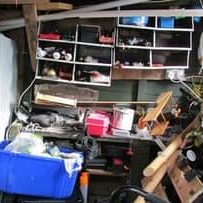Having a build up of clutter, whether it be in the form of electricals, heirlooms or pre-loved objects, can cause your property to quickly become one of chaos, but how can you know when enough really has become enough? Throughout the country, there are households which have formed a strong bond with their belongings in one way or another, disabling them of the power of removing them from their homes for recycling or donation purposes. These people can be known as Britain’s hoarders.
From minimal hoarding to persistent collecting, it can often be found difficult to let go, so here are our top five tips to cut those habits.
Recognise the signs of hoarding
Without knowing too much about the signs, it can be difficult to come to the conclusion that you, or one of your loved ones, are a hoarder. Excessive hoarding has been classified as a mental disorder, but not all cases can be as extreme as the next. The textbook definition of a hoarder is a person who may collect and hold on to objects which others may perceive as worthless. By understanding these signs, you may be able to help yourself or a loved one with the following steps of cutting ties with unneeded belongs.
‘The more the merrier’ is not always the case
One of the simplest ways to cut down on the objects being kept within your property is to seek any duplicates. You may have two versions of a slow cooker, or two lawn mowers, keeping a spare nearby at all times ‘just in case’. If the 2nd item hasn’t been utilised within the last six months, or even taken out of the box at all, place it in the removal pile.
Set your emotions aside
Moving onto the objects which you feel an emotional attachment to can be tricky to deal with. Without thinking too deeply, take a moment to think about when you last sat and observed or used these beloved objects, such as your child’s first dolls house or your first bike. It may be that, just knowing the objects are in reaching distance provides you with a comfort, but it could also be that leaving them sitting in your loft space, shed or garage for a wealth of years could be allowing them to gather dust and mould, decaying the quality as well as the ability for use. By setting your emotions aside, you will be able to think proactively, allowing you to shift a number of items into your removal pile for donation or waste collection.
Categorise
It can be easy to reach a point where you feel exhausted when clearing out a large quantity of belongings. By categorising your items, you can process them both mentally and physically, productively working your way through the piles one by one. The categories can be selected as anything that suits you, such as “items which haven’t been utilised for 6 months”, “items you can’t find a use for” or “family heirlooms”. These can then also be tackled over a series of days or weeks, preventing you from becoming overwhelmed.
Plan the disposal of your belongings
Leaving your beloved items in a black bin-bag outside your home until waste collection day arrives can be one of the most painful parts of cutting connections with your hoardings, but that is not your only option. If your items do not meet the regulations for charity shop acceptance, there are still ways of having your items removed from the perimeters of your home within the same day, such as same-day skip drop off and removal, or waste collection vans who can collect your household or garden belongings, taking them off of your hands and over to safe recycling sites, protecting the environment whilst leaving you clutter free.
Here at Junk Taxi, our skip and waste collection services are available throughout the week for any commercial, domestic or garden waste requirements. To get in touch with a member of our team, give us a call on 02030922961 and we will be happy to assist and advise you, no matter your query!

